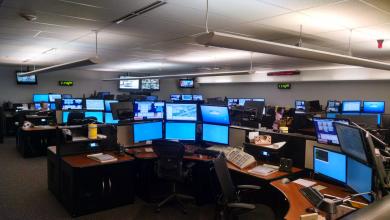Background
Lancaster County-Wide Communications (LCWC) is a result of a proposal made to the Lancaster County Commissioners by the Lancaster Law Enforcement Officers Association in the early part of 1966. Dispatchers were hired in November of 1971 and LCWC (then known as the Lancaster County Public Safety Communications System - LCPSCS) went into operation on January 1, 1972. The police system began with two departments, the Lancaster County Sheriff's Office and Strasburg Borough Police Department.
In June of 1972 the Lancaster County Fireman’s Association voted to participate in a county-wide fire communications system. Dispatchers were hired in July of 1973 and the Lancaster County Fire Dispatch System began operation on September 7, 1973. The fire system started with seven fire departments and two ambulances. The Lancaster City Fire Department joined the system on June 10, 1980.
Facilities
- 1966 – LCWC was located at 900 E. King Street, in the basement of the old hospital building behind Conestoga View
- 1977 – In April, LCWC moved into the basement of the new Lancaster County courthouse annex at 50 North Duke Street
- 1994 – In August, LCWC relocated to its current facility.
- 1999 – An addition was constructed at the current facility.
Technology
In February of 1979, the County of Lancaster submitted a grant application for the implementation of a 911 emergency telephone system and in October 1979 the first call was received on the 911 switchboard. In March of 1986, the United Telephone Company converted the Mountville office to receive 911, which made 911 available to all citizens and visitors in Lancaster County.
The UHF medical radio system became operational in July of 1980 enabling the basic and advanced life support units greater flexibility in contacting the hospitals. In addition, Advance Life Support units gained the capability of transmitting telemetry to the hospitals allowing physicians to diagnose the condition of a patient’s heart.
Because of the additional frequencies, increased personnel and the need for expansion, it was decided to computerize the operations at LCWC. In January of 1984, new consoles were installed which allowed the transmitters and receivers to be controlled by computer. Computer Aided Dispatch (CAD) was implemented in September of 1991, upgraded in August 1999 and again in 2008. CAD streamlines many of the previously separate, manual functions performed by dispatch staff into simultaneous actions.
In the spring of 2013, LCWC began deploying Text-to-911. All of the Big-4 wireless providers were deployed by the summer of 2014.
In the fall of 2013, the communications center was completely renovated. Larger workstations, coupled with a new room layout, allow staff additional workspace to accommodate the many new flat screen monitors displaying a variety of software applications used to dispatch and support all of the agencies dispatched by LCWC.
In October 2013, LCWC began deploying the new COR P-25 Digital Trunked Radio System. In 2014, the P-25 system replaced the county’s conventional, analog radio system, which was in use since the inception of LCWC in the early 1970’s.
Operations
Throughout the 1970’s and early 1980’s, municipal remote dispatch points gradually closed and became part of LCWC. In November 1993, LCWC started dispatching for the Lancaster City Police Department, the final remote dispatch point. This addition marked the end of an era for remote dispatch points in Lancaster County. Lancaster County-Wide Communications became the sole Public Safety Answering and Dispatch Point for all emergency services, public safety agencies, and related support agencies within Lancaster County.




